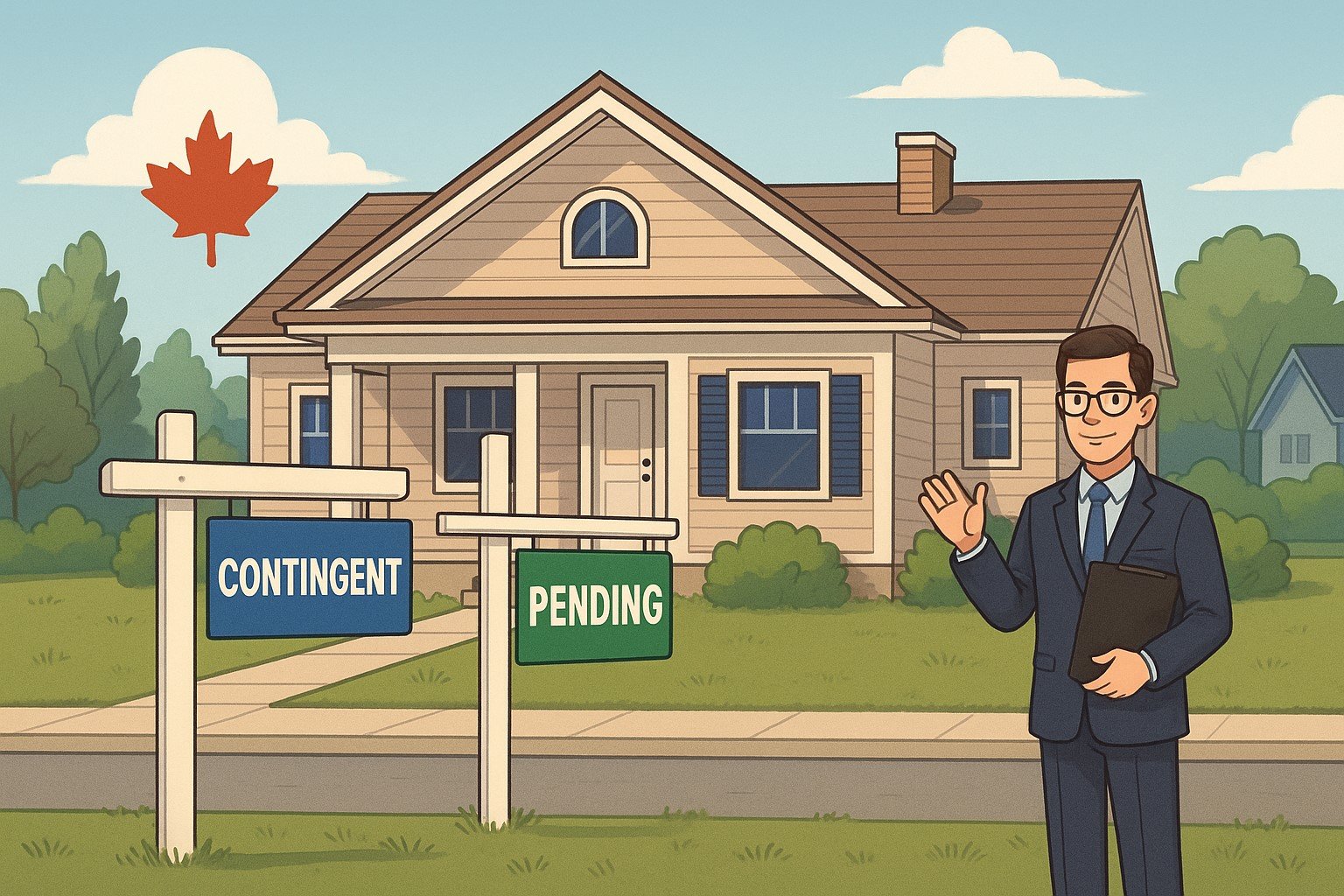
Contingent vs. Pending in Real Estate: What’s the Difference in Canada?
Understand the key differences between contingent and pending home listings in Canada. Learn what each status means and how it impacts your homebuying decision.
If you’ve ever browsed real estate listings, chances are you’ve seen the words “contingent” or “pending” attached to a home for sale. While they may sound similar, they have very different meanings — and understanding them could help you avoid disappointment or even score a dream home that’s still within reach.
In this guide, we’ll walk you through exactly what these terms mean, how they’re used in Canadian real estate listings, and what your options are if you come across a home marked contingent or pending.
📊 Contingent vs Pending – Status Comparison
🔁 Contingent
- ✅ Offer accepted by seller
- ⚠️ Buyer must meet specific conditions
- 🔍 Home may still be shown
- 📬 Backup offers allowed
- 📉 Moderate to high fall-through risk
✅ Pending
- ✔️ All conditions met or waived
- 🔒 Final processing before close
- ⛔ Usually closed to new offers
- 📦 Buyer preparing for closing
- 📊 Very low fall-through risk
📌 Tip: “Contingent” may still offer entry points. “Pending” means the deal is nearly done.
What Does “Contingent” Mean on a Listing?
A home marked contingent means the seller has accepted an offer — but certain conditions (contingencies) still need to be met before the deal can close. These could include financing approval, home inspection, or legal review.
In this state, the home is technically still on the market, because if the buyer fails to meet those conditions, the deal could fall through — and the seller will likely consider backup offers.
🧠 Example: A buyer makes an offer that’s accepted, but the deal is contingent on them selling their current home. If that sale doesn’t happen by the agreed deadline, the deal collapses and the home goes back on the market.
What Does “Pending” Mean on a Listing?
A pending home means all contingencies have been met or waived. The sale is essentially in its final stages — the deal is awaiting closing, and the buyer is expected to take possession soon.
At this stage, the home is no longer actively available, and it’s rare for a seller to entertain new offers. The chance of a deal falling through is low, but not impossible.
📈 Timeline: Contingent → Pending → Closed
Seller accepts offer. Status: Contingent. Conditions must be met to proceed.
Buyer clears financing, inspection, or home sale. Deal still at risk here.
Conditions fulfilled or waived. Status updates to Pending.
Buyer takes possession. Listing marked as Closed/Sold.
📌 Note: Timelines vary by province, but this is the typical path in Canadian home sales.
Common Contingent Statuses in Canada
Different provinces and agents may use slightly different terms, but here are some of the most common contingent labels you’ll see in Canadian listings:
🔹 Contingent – Short Sale
The seller is trying to sell the home for less than what they owe on the mortgage. The offer is accepted, but the sale needs lender approval — which may take weeks or months and often falls through.
🔹 Contingent – Probate
Used when the seller has passed away, and the sale depends on the approval of an estate or court process. This status typically involves long timelines and legal delays.
🔹 Contingent – Continue to Show
The seller has accepted an offer, but is still showing the home to other potential buyers in case the original deal fails.
🔹 Contingent – No Show
The seller has accepted an offer and is no longer showing the property, but the buyer still has conditions to meet. This typically means the seller is confident the deal will close.
🔹 With or Without Kick-Out Clause
If a kick-out clause is included, the current buyer has a deadline to meet their contingencies. If there’s no kick-out, they could take as long as necessary — making it harder for backup buyers to step in.
📋 Common Contingent Labels in Canadian Listings
| 🏷️ Label | Meaning | Buyer Action |
|---|---|---|
| 🔁 Contingent – Continue to Show | Offer accepted, still open to showings | ✅ Schedule and offer |
| 🚫 Contingent – No Show | Offer accepted, no more showings | ⏳ Monitor only |
| ⚖️ Contingent – Probate | Legal process must conclude first | 📝 Expect delays |
| 💸 Contingent – Short Sale | Bank must approve under-mortgage offer | 📉 Risky — proceed carefully |
| ⏱️ Contingent – Kick-Out Clause | Buyer has a set deadline to fulfill terms | 📬 Submit backup offer |
📌 Tip: Confirm listing label meaning with your realtor — local rules vary.
Common Pending Statuses Explained
Even a “pending” deal can have different meanings. Here are some labels to watch for:
🔸 Pending – Short Sale
The seller has accepted a short-sale offer, and all contingencies are cleared — but the deal still needs final approval from the lender, which can be delayed or denied.
🔸 Pending – Taking Backups
The sale is pending, but the seller is still accepting backup offers, just in case the buyer backs out at the last minute.
🔸 Pending – More Than 4 Months
This status appears automatically when a listing has been pending for over 120 days. It could be a slow closing or just an outdated listing that wasn’t marked as sold.
📊 Contingent vs Pending – Fall-Through Risk Comparison
| 🏷️ Status | Risk | Backup Offer? | Buyer Action |
|---|---|---|---|
| 🔁 Contingent – Continue to Show | Mod–High | ✅ Yes | Prep Backup |
| 🚫 Contingent – No Show | Moderate | 🚫 Unlikely | Track Status |
| 📄 Pending – Taking Backup | Low–Mod | ✅ Yes | Optional Offer |
| ✅ Pending – Final Stage | Very Low | ❌ No | Move On |
📌 Note: Status names may differ by MLS or region — confirm with your agent before acting.
Can You Make an Offer on a Contingent or Pending Property?
✅ Contingent? Yes, sometimes.
You can submit a backup offer on a contingent home — especially if the seller is still showing it. Whether your offer is considered depends on the type of contingency and how close the deal is to collapsing.
❌ Pending? Rarely.
Most pending deals prohibit the seller from accepting new offers, especially if the buyer has fulfilled all obligations. You can still monitor the listing in case it comes back on the market.
Frequently Asked Questions
Can I still view a contingent property?
Yes, especially if it’s labeled “continue to show.” It means the seller is open to backup offers while contingencies are cleared.
Is a pending deal guaranteed to close?
Not 100%, but it’s very likely. The deal has cleared all hurdles and is now just waiting for legal and financial formalities.
Which status is riskier for buyers: contingent or pending?
Contingent deals have more risk of falling through, which can be a good opportunity if you’re ready with a backup offer.
Final Thoughts: How to Navigate Contingent and Pending Listings
Knowing the difference between contingent and pending could save you time, heartbreak, and possibly land you a home others have overlooked.
If you’re actively house-hunting, don’t just filter by “available” listings. A contingent property may still be worth pursuing — especially if you’re prepared with a strong offer and flexible closing timeline.
And if you’re unsure whether to jump on a listing marked pending or contingent, it’s always smart to consult a local mortgage expert or real estate agent. They’ll help you strategize your next move — and avoid wasting time on homes that are out of reach.
📞 Talk to a Real Estate Pro
Confused by listings marked “contingent” or “pending”? Speak with a licensed real estate advisor to understand your options and get expert guidance on how to move forward with the right offer.
💬 Ask an Expert NowStuck with a Mortgage Decision?
Don’t stress — our team is here to help. Reach out for free, no-obligation guidance.
Contact the Experts



